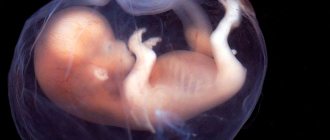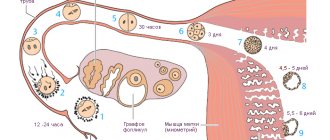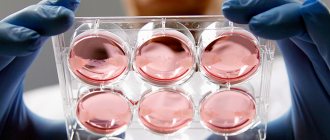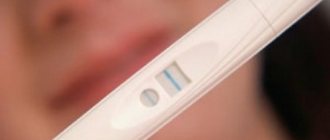Stages of embryo development during IVF
When performing IVF, the development of the embryo occurs quickly day by day, each new day is a new stage, different from the previous one.
Embryo development during IVF is the first day: the presence of both male and female nuclei is assessed.
Development of the embryo after IVF by day - Second day: development of the embryo after IVF proceeds at a rapid pace,
there is a connection of genomes: male and female. Experts evaluate the quality and shape of the resulting embryo.
Third day: the embryo divides during IVF, it grows and consists of 6 blastomeres.
Fourth day: this day is as important as all the previous and subsequent ones; every day the individual development of the embryo occurs, which on the fourth day is called the formation of the morula. The morula consists of 10-16 blastomeres and during spontaneous pregnancy at this stage the embryo reaches the uterine cavity through the fallopian tube.
Fetal development after IVF by day - the fifth and sixth days. It is also a rather crucial period in the life of the embryo, which from this moment is called a blastocyst. These days, hatching occurs - the release of the blastocyst from the zona pellucida; it is at this moment that the blastocyst is ready for implantation. Basically, at this stage, the embryos are transferred into the uterine cavity of the expectant mother. If necessary, embryologists can perform pre-hatching to increase the chances of successful implantation.
Embryo development during IVF by day - seventh day. This is the day on which the embryo attaches to the endometrium and implants. The success of the ongoing in vitro fertilization protocol depends on the success of this moment.
Further development of the embryo occurs without any differences from spontaneous pregnancy.
Signs of pregnancy after embryo transfer
To treat infertility in our time, in vitro fertilization (IVF) technology is becoming increasingly popular, during which eggs are fertilized and cultured outside the woman’s body, after which the fertilized oocytes are transferred into the uterine cavity of the expectant mother for further development, as in a normal pregnancy. Childbirth after IVF is also no different from childbirth after a natural pregnancy.
Indications for IVF
The in vitro fertilization procedure is carried out if an infertile couple has the following pathologies that prevent natural conception:
female infertility • absolute tubal (in the absence of fallopian tubes or their obstruction); • endocrine (not amenable to hormonal treatment); • unexplained infertility; • infertility associated with the presence of endometriosis; • cervical factor of infertility (in the absence of effectiveness of artificial insemination); • absolute infertility (in the absence or functional inferiority of the ovaries); male infertility • oligoasthenozoospermia; mixed infertility • with a combination of female and male factors of infertility.
Contraindications to IVF
Contraindications to IVF are the presence of the following pathologies:
• somatic and mental diseases in which pregnancy is contraindicated; • congenital anomalies (in case of repeated birth of children with developmental defects of the same type, with chromosomal abnormalities); • hereditary diseases; • hyperplastic conditions of the ovaries and uterus; • malformations of the uterus; • synechiae in the uterine cavity.
The essence of the IVF procedure
At the first stage of the procedure, superovulation is stimulated under the control of echographic and endocrinological monitoring. Then, under ultrasound guidance, the preovulatory follicles are aspirated. The next important step is the cultivation of fertilized eggs “in vitro”, in a special environment, for 3-5 days, after which they are transferred to the woman’s uterine cavity.
How to behave after IVF
The period after embryo transfer into the uterine cavity is extremely painful and emotionally stressful, which is understandable, because often for a couple who decided to undergo the IVF procedure, the path to parental happiness was strewn with obstacles and disappointments. Having received hope - having undergone artificial insemination, a woman, as a rule, exhausts herself with nervous experiences associated with the fear of failing again. This is fundamentally wrong behavior, since after IVF the expectant mother, more than ever, needs the absence of stress and a calm, measured rhythm of life.
To improve the condition, you can use simple sedatives: tincture of motherwort, valerian, herbal sedatives. It is possible to take other drugs that have a stronger sedative effect, but their use must be previously agreed with the attending physician.
Lifestyle after embryo transfer
After IVF (after embryo transfer), some restrictions are introduced into a woman’s life:
• after embryo transfer, your lifestyle should become calm and sedentary; • for the first 24 hours after the IVF procedure, it is recommended to remain in bed, refusing to go to the bathroom or shower; • it is necessary to exclude physical activity (housework, physical education, sports); • limit heavy lifting and any bending of the body; • refuse to drive a car; • take walks in the fresh air, at least 20-30 minutes a day; • limit sexual contacts; • avoid being in too hot or too cold rooms (saunas, baths, swimming pools); • maintain a sleep and rest schedule; • refuse to wear tight trousers and jeans; • adhere to a balanced diet: the daily diet should include a large amount of natural products without preservatives, lean meat, natural fish, poultry, fresh vegetables, fruits, dairy products; • drink enough fluid (at least 2.5 liters per day); • limit the consumption of legumes, sauerkraut, smoked products, mushrooms; • avoid being in crowded places and communicating with sick people.
Embryo implantation after IVF
Implantation after IVF occurs within forty hours from the day after the embryo is transferred into the uterine cavity of the expectant mother, and it is at this time that special attention should be paid to the recommendations of the attending physician.
Hormonal support after IVF
After the procedure, some women note the appearance of scanty bleeding and minor nagging pain in the lower abdomen. As a rule, these conditions are caused by the support of early pregnancy with hormonal drugs. Often, after IVF (after embryo transfer), a woman is prescribed medications with progesterone (Utrozhestan, Duphaston, micronized progesterone), which support the function of the corpus luteum. For the administration of drugs containing progesterone, various schemes and individual dosages are used, the choice of which is carried out in accordance with the state of the endometrium and the level of endogenous hormone synthesis.
Diagnosis of successful implantation
It is impossible to feel the implantation of the embryo itself, despite the fact that almost every woman tries to detect certain symptoms of conception after IVF. Signs of pregnancy: the appearance of drowsiness, dizziness, nausea, swelling of the mammary glands - are only subjective and cannot unconditionally indicate the success of the procedure. A more reliable proof of the presence or absence of pregnancy is a hCG test after IVF, which is recommended to be performed no earlier than two weeks after embryo transfer. A test after IVF carried out earlier will not give reliable results, since the level of the hCG hormone, the change in which this test is based, is still too low.
The main diagnostic method, which 100% confirms the occurrence of conception, is ultrasound. After IVF, it must be done on days 21-22. Using this study, you can verify the absence of ectopic (ectopic) pregnancy and determine the number of fertilized eggs (whether the pregnancy is multiple, since twins after IVF are not uncommon).
After successful implantation and pregnancy following IVF, a woman begins to experience signs of pregnancy that are similar to those of a normal pregnancy.
It is necessary to regularly measure general body temperature and basal temperature after IVF. Body temperature, as a rule, remains within normal limits. Most women experience an increase in basal temperature, which is associated with hormonal changes in the body.
Discharge after IVF
Discharge after IVF may be light, liquid in consistency, and in some cases bloody, which is normal and indicates implantation. A woman should be wary of their continuation for more than two days, as well as a change in their color and smell: if the discharge has acquired a yellow-green or brown tint, an unpleasant odor, and the amount of blood impurities in it has increased.
Pain after IVF
Nagging mild pain in the lower abdomen a few days after embryo transfer is normal and is associated with the process of implantation of the embryo into the wall of the uterus.
Menstrual cycle after IVF
If an attempt at artificial insemination is unsuccessful, women's periods after IVF, as a rule, are restored at normal intervals. Non-occurrence of menstruation with a negative hCG test and absence of pregnancy confirmed by ultrasound does not give hope for positive results after IVF.
Menstruation after unsuccessful IVF may be delayed due to continued use of hormonal drugs or the physiological characteristics of the woman.
The IVF Center clinic in Nalchik has extensive experience in successfully conducting IVF procedures, as evidenced by the results: 49.7% of the first attempts are successful!
Thanks to modern medical equipment and the professionalism of our specialists, hundreds of couples have already managed to experience parental happiness, and you can join their number by contacting us by phone or filling out an application on the clinic’s website. We will be happy to assist you!
LOS calculator after IVF
During in vitro fertilization, the fusion of sperm with the egg is usually carried out 2-6 hours after sampling the material from the follicles. After 3-5 days, implantation into the uterus is carried out and implantation occurs after approximately 2-4 days. If we compare this process with a woman’s natural cycle, then implantation occurs 5-8 days after ovulation.
The due date calculator can calculate both embryonic and obstetric gestational ages. In the first case, it is necessary to count from the moment of egg collection, and in the second, add another two weeks to this day.
You can also use ready-made calculators. They only need to specify two parameters:
- the exact date of transfer of the fertilized egg into the uterus;
- the stage of development of the embryo during transplantation (its “age”, calculated in days).
After this, you need to click the “calculate” button, and the calculator will display the expected date of birth after IVF.
During pregnancy, various situations can occur that can either bring the child closer or, conversely, delay the date of birth of the child.
None of the above methods or calculators can guarantee that this particular number is the due date. All calculators, methods and methods of calculation are only relative. Much depends on the mother’s body, the duration of the menstrual cycle and the individual developmental characteristics of the baby.
When issuing a prenatal sick leave certificate, as a rule, they rely on ultrasound data and the first day of the last menstruation with a short protocol. For long protocols, they are based on the ultrasound method.
Other drugs for IVF
In addition to hormones, other drugs are also used in the practice of reproductive medicine. The most common of them are:
- Adrenal hormones (Dexamethasone, Prednisolone or Cortisol) are often used to create immune bonds between the mother and the fetus she is carrying, as well as to reduce the level of androgens. Also, these drugs eliminate the development factors of the antigen to the hCG hormone, eliminating fetal hypoxia and preventing premature birth in a woman.
- Gonadotropin preparations for the physiological maintenance of pregnancy mechanisms. In this case, two types of these hormones are used: HMG and FSH preparations. The drugs most often used in clinics are Menopur, Elonva, Puregon, and Gonal-F. All these drugs are perceived by the body as natural and do not cause a reaction from the immune system. However, when taking them, there may be side effects (fatigue, anxiety, flatulence, etc.) Also, when taking gonadotropes, there may be a danger of ovarian hyperstimulation
- HCG preparations duplicate the natural hormones of the female body and contribute to the development of mechanisms for the safety of the fetus. The drugs Profasi or Pregnil are used as analogues of hCG.
- Blood thinning drugs (Aspirin, Heparin, Curantil) are often prescribed to pregnant women to maintain normal blood thickness and reduce platelet aggregation. These medications are prescribed under the control of a blood test. They ensure normal blood circulation in the uterus and placenta, preventing oxygen starvation of the fetus.
- Antihypoxic vitamins (folic acid, vitamins A, B and E, beta-carotene) are prescribed to provide vitamin support to the body of the mother and the unborn baby, maintaining their immunity at a sufficient level.
No pregnancy after IVF should be left to chance. Women with pathologies who, without modern technologies, would be doomed to lifelong infertility are turning to the in vitro fertilization technique. As a rule, in these difficult situations, the body does not have the resources to help a woman not only become pregnant on her own, but also maintain the pregnancy.
If a woman has already decided to undergo IVF, then without medical support in most cases she will not be able to endure the pregnancy that she has so dearly received. The main thing is to trust a good doctor and take all medications according to the regimen prescribed by the doctor. But all this is done so that a woman can experience the great happiness of finally becoming a mother.
Similar articles
No similar articles
Fetal development by week of pregnancy during IVF
The first trimester is the most crucial time for the development of a new life. It is during this period that the development of a small person occurs every second
USEFUL INFORMATION: Sage for infertility reviews
Right now, it is so important to avoid any adverse effects on a woman’s body, ranging from psychological factors to bad habits and taking any medications if they are not prescribed for health reasons, as well as to support the luteal phase. Impact at any stage of adverse effects can lead to various complications, even fetal malformations
Therefore, you need to be as responsible and careful as possible during this trimester of pregnancy.
The week after IVF, namely the week after fertilization, corresponds to the period of implantation of the embryo into the woman’s endometrium. The duration of implantation is approximately two days.
Progesterone support after successful IVF
Progesterone is one of the most important hormones for maintaining pregnancy. Its main functions at this moment are:
- creating the most favorable conditions for the endometrium for reliable implantation of the embryo;
- reducing the risk of endometrial contraction, preventing the risk of miscarriage;
- maintaining the cervical canal closed.
Currently, women after IVF are prescribed progesterone in the form of regular or vaginal tablets. Progesterone in the form of injections is extremely rarely used at this point due to the inconvenience for the expectant mother. In addition, prolonged injection often results in soreness, bruises, or even abscesses at the injection site.
Preparations for progesterone support
- Duphaston. It is used in tablet form. It is believed that this medicine can be used long-term without the risk of harm to the mother or fetus. However, some reproductive specialists are cautious about prescribing it to pregnant women. Duphaston should be taken daily, at the same time. Its dose ranges from 30 to 60 mg.
- Utrozhestan. This is the most popular drug for hormonal correction of the female body. It was invented by the French company Besins and is micronized progesterone. This medicine is obtained from plant materials. It is used in the form of vaginal capsules. Moreover, 600 mg of micronized drug is comparable to 6 injections of progesterone. To prevent leakage, it is advisable to place the capsule as deep as possible, close to the cervix. Most often, the drug is used 1 capsule (200 mg) two to three times a day at equal time intervals (600 mg per day). Sometimes the doctor may prescribe an increased dose of this drug: a capsule 4 times a day with parallel double administration of a 2.5% oil solution of the same drug.
- Progesterone in the form of an oil solution (1 ml of 2.5% or 1%) can be administered in the form of intramuscular or subcutaneous injections. But the method of administration in the form of “oil injections” can cause pain during injection and increase appetite. After just a week of injections, women complain of pain in the buttocks from the injections.
- Lutein. It contains the same progesterone, but is used sublingually 3-4 times a day, 100-150 mg (under the tongue) or intravaginally, 2 times a day, 150-200 mg (inside the vagina). The dose for hormonal support is determined by the doctor.
- Crinon. This is a gel for vaginal use with progesterone. It is administered with a special applicator. This type of support is good because it ensures saturation of the body for 3 days after administration. This drug leaks less from the vagina than Utrozhestan, especially in summer. Also, this medication has minimal effect on the liver.
Features of use
Any hormonal drugs must be taken taking into account their “insidiousness”, since their thoughtless use or withdrawal can harm the health of the woman or fetus.
Therefore, there are a number of rules when using progesterone-containing drugs:
- Progesterone-containing medications are usually started on the day the woman's eggs are collected, continuing until pregnancy is confirmed, and then until 12 weeks of pregnancy. When prescribing their dosage, the doctor must take into account all the individual factors of the pregnant woman (endometrial thickness, own progesterone level, etc.)
- The use of this group of drugs can introduce some inconvenience into a woman’s life: the need to insert the drug several times into the vagina or perform an injection during work.
- The appearance of “side effects” when using drugs for progesterone support in pregnant women in the form of weight gain, increased appetite, dizziness or weakness.
- Discontinuation of drugs containing progesterone is carried out according to a withdrawal plan (with a gradual dose reduction). Under no circumstances should you suddenly stop taking these medications. Before discontinuing drugs of this group, a blood test is most often prescribed to determine the level of the hormone in a woman’s body. It is most often possible to completely abandon progesterone support at 14-15 weeks of pregnancy. But at the same time, there should be no abnormalities in the expectant mother’s body. In addition, the woman must have a fully formed placenta, which takes on all the functions of maintaining the pregnancy. If a woman has risks of miscarriage during this period, then progesterone support can last up to 20 weeks.
Prenatal diagnosis during IVF pregnancy
Non-invasive methods:
- general clinical analysis of blood and urine;
- blood chemistry;
- determination of blood group, Rh factor, blood testing for hepatitis B and C, HIV, Wasserman reaction;
- blood sugar test;
- hormonal blood test;
- coagulogram and D-dimer;
- prenatal genetic screening;
- blood test for antibodies and antigens;
- diagnosis of chromosomal pathologies and fetal sex using maternal blood;
- Ultrasound, 3D ultrasound, 4D ultrasound;
- ECG;
- Dopplerometry;
- CHT;
- Ultrasound of all internal organs and vessels.
Invasive methods:
- chorionic villus biopsy;
- biopsy of the placenta;
- amniocentesis;
- cordocentesis.
Prenatal diagnostics at Mother and Child is the “expert class” in the field of prenatal research. Our centers are equipped with all the necessary equipment to carry out any type of functional diagnostics, and our own laboratories allow us to obtain the results of laboratory tests in the shortest possible time.
Natural conception after unsuccessful in vitro fertilization
After unsuccessful IVF, the body’s ability to conceive naturally also increases. This is especially true in the first month after an unsuccessful procedure. Since the parents were prepared for the protocol: they followed the regime, received medication and hormonal support for the body - all this is a favorable background for the onset of a “spontaneous” pregnancy.
Sometimes psychological factors interfere with pregnancy. There are no contraindications to conception due to health reasons, but a woman cannot become pregnant. This may be due to excessive experiences and reflection on this topic. On the other hand, the woman herself is not psychologically ready for the birth of a child and has hidden anxieties. In these cases, not medical, but psychological help is required.
In vitro fertilization is a real opportunity to become parents when the situation seems hopeless.
However, it should be remembered that this is not a magical panacea, but a serious medical procedure. First, it requires responsible preparation on the part of parents. Secondly, there is no need to be afraid of failure.
According to statistics, only a third of the protocols end in pregnancy. That is, if for one woman pregnancy occurs from the first procedure, then for another it can happen only after the third, fifth or even tenth attempt. The chances of a natural pregnancy do not disappear, so it is necessary to include all possible options, because a real miracle is at stake - a new life.
Signs and symptoms of pregnancy
Many women claim that the first symptoms of pregnancy can be felt already on the second day after embryo transfer. There is no clear medical explanation for such statements. Doctors do not compare the characteristic signs that appear with successful fertilization. They believe that this is due to active hormonal therapy preceding IVF and residual effects of hCG injections.
For medical reasons, a woman may experience the following changes:
- First day. There is a nagging pain in the lower abdomen and lower back.
- Second day. Bloating appears and the functioning of the gastrointestinal tract is disrupted.
- The third day. Possible increase in body temperature. If the mark goes beyond 37.5˚C, this is a reason to consult a doctor.
- Fourth day. The pain in the lower abdomen subsides.
- Fifth day. Discomfort in the pubic area.
- Sixth day. Nagging pain in the lower abdomen appears again, reminiscent of the onset of menstruation. It is believed that during this period the embryo implants into the walls of the uterus. If this does not happen, the embryo dies.
- Seventh – eighth day. Sometimes there is a spotting discharge. They may mean successful implantation of the embryo or the beginning of a new menstrual cycle.
- Ninth to tenth day. A pregnancy test may show a weakly positive result, but the absence of a second red line does not mean IVF failure.
- Thirteenth to fourteenth day. Significant symptoms of pregnancy appear. There is a reaction to the hCG level (positive pregnancy test).
A pregnancy test is not a reliable way to confirm pregnancy.
There may be residual hCG in the body after injections performed before the extracorporeal procedure. Only an ultrasound examination can confirm fertilization.
When is it carried out?
If pregnancy does not occur naturally, the future parents, primarily the woman, undergo a thorough comprehensive medical examination.
The reasons can be different, both somatic and psychological. Before you think about IVF, eliminate possible factors why conception does not occur. As a rule, the lion's share of couples experiencing such problems do not proceed to IVF. The list of indications for prescribing IVF is clear: these are physiological female and male infertility of certain forms, as well as cases where, after a long examination of the couple, the cause of infertility has not been identified.
USEFUL INFORMATION: Pregnancy after Yarina
What is biochemical pregnancy
After fertilization, the trophoblast of the embryo begins to secrete human chorionic gonadotropin. But its concentration is not yet sufficient to be determined using a pregnancy test. Hormone levels increase, but at an early stage the development of pregnancy stops and menstruation begins.
It is possible to determine that conception has occurred only with the help of a blood test, changes in which persist for several more days. Therefore, such a pregnancy is called biochemical.
Before the widespread use of IVF, no one knew about this problem. But with the beginning of the use of assisted reproductive technologies, control over each stage of pregnancy progression began. Observations have shown a high frequency of this condition.
Briefly about IVF
In vitro fertilization is considered one of the most effective methods among assisted reproductive technologies. The conception process is carried out in a test tube, where the egg and sperm are placed. The resulting embryo is grown for 5-7 days, after which it is ready for implantation into the uterus of the expectant mother.
In order for pregnancy to occur after IVF, the preparation of the woman’s body is important. Therefore, drug therapy is carried out aimed at increasing the level of progesterone in the blood. This leads to hyperovulation with the development of several dominant follicles, as well as the proliferation of the endometrium in the uterus. Simply put, not only the eggs are prepared, but also the site for embryo transfer.
Thirty-first thirty-fourth week
The baby weighs about 2.5 kilograms. And the length reaches 40-45 centimeters.
The fetus has clearly defined periods of sleep and wakefulness. When he sleeps, his eyes are closed, while he is awake they are open, active movements and tremors are also characteristic of this stage of development.
At 34 weeks, due to the enlargement of the fetus itself, there is less space for it. Therefore, movements are felt less often, but stronger in intensity. At this stage, it is already quite difficult for the fetus to radically change its position and its presenting part is already established above the entrance to the pelvis. We can already talk about the presentation of the fetus: cephalic. If the child does not lie longitudinally, then his position is designated as transverse or oblique.
Hair growth occurs on the head, all bone and joint elements of the skeleton are strengthened.
All organs and systems function as usual, each performing its own function.
Thirty-fifth week – thirty-seventh week.
The fetus continues to actively gain weight; in 1 day the increase can be about 30 grams. At this stage, the genetic aspects of the size of the fetus, which were transmitted to it from the mother and father, are included, that is, its size can vary significantly in pregnant women, depending on the genetic characteristics of the parents. At 37 weeks, the pregnancy is called full-term and labor can begin at any moment, which will no longer be considered premature, but is called urgent, that is, completed on time. In the following weeks, the child gains weight and waits for the long-awaited meeting with his mother.
Correct behavior before embryo transfer
Embryo transfer is the final and most important part of the IVF protocol, requiring proper preparation of the patient and high skill of the attending physician. Before the transfer, the patient should avoid physical activity, prefer foods that do not cause gas formation, and follow the instructions of the attending physician (usually progesterone, folic acid, and some individually selected medications are prescribed).
In the process of monitoring the development of the embryo, the attending physician is in constant contact with the embryologist and the future parents, discussing with them the prospects of transfer on a daily basis. Depending on the number of embryos and their quality (link to embryo quality assessment), the transfer is carried out either on the third or fifth day of embryo life. If there are few embryos or they develop with a delay, a decision is made to transfer on the 3rd day, and it is preferable to transfer 2 embryos at once. If the quantity and quality of embryos allows, they continue to be observed until the 5th day, until the so-called formation. blastocysts (link to embryo quality assessment). The procedure is performed with a full bladder. The most important thing is a positive attitude, trust in your doctor and clinic, maximum peace of mind and confidence in success!
Embryo transfer during IVF is a technically complex procedure. In our clinic, it is carried out with constant ultrasound control, and both the doctor and the expectant mother can see on the screen everything that happens in the uterus, right down to the place where the embryo is placed. The transfer is carried out using an ultra-thin catheter with a special coating that does not damage the embryo. The entire procedure usually lasts no more than 5 minutes and is absolutely painless. The “gold standard” is the transfer of one healthy embryo to prevent multiple pregnancies, which is considered a complication of IVF. The option of twin pregnancy must be discussed with patients before the transfer, regardless of how many embryos are transferred, because Even with the transfer of one embryo, twins are possible.
Self-pregnancy after unsuccessful IVF
Some patients, after unsuccessful attempts at artificial insemination, radically change their lifestyle. They follow a daily routine, watch their diet and lead an active lifestyle. In some cases, such positive changes lead to improved hormonal levels. Doctors know of many cases where a woman became pregnant on her own after unsuccessful IVF. In practice, experienced specialists may experience several such spontaneous pregnancies. Improvement in reproductive function may also be affected by the use of medications during and after the protocol. In this case, natural pregnancy after unsuccessful IVF becomes the logical conclusion of hormonal therapy, which was aimed at maintaining artificial insemination.
A diagnosis of infertility does not mean that a woman will never become a mother, but simply says that her chances are slim. Medical statistics prove that pregnancy after unsuccessful IVF is quite possible. In addition, there may not be only one birth, and the possibility of conceiving a child naturally is not excluded. However, the probability of spontaneous pregnancy after IVF is less than 2%, so think about whether it’s worth wasting months and years hoping for a miracle? A professional approach will help you achieve results faster, so do not delay contacting the clinic. Come to the IVF Center. Answers to all questions regarding pregnancy after an unsuccessful IVF attempt will be provided to you by qualified specialists from our medical center. To schedule a consultation, call and come to the clinic.
USEFUL INFORMATION: What discharge looks like during implantation of the fertilized egg
Free appointment with a fertility specialist at the IVF Center clinic until December 31, 2019 Days left: 28
Dear patients! The IVF Center clinic invites you to a free appointment with a fertility specialist, including an ultrasound and drawing up a treatment plan.
Other articles
What is IVF in a natural cycle?
The IVF protocol in a natural cycle (NC) is the most gentle procedure of all in vitro fertilization programs.
Read the article
PGD for IVF. What is PGD and why is it needed?
Many potential parents planning in vitro fertilization are interested in the question: PGD during IVF - what is it? What is the essence of this procedure and is it as important and safe as doctors claim?
Read the article
What happens after IVF: pregnancy and its features
When the replanting is completed, you should follow the doctor's recommendations. Indeed, in 30% of cases, pregnancy after IVF ends in miscarriage in the early stages. To reduce risks, the expectant mother is prescribed special medications. Medicines maintain a certain hormonal balance and increase the concentration of progesterone. This will help the embryo to gain a foothold and begin to develop.
Given the increased risks, obstetricians-gynecologists are more attentive to monitoring patients after in vitro fertilization. Do not forget that you should report any changes in your health to your doctor in a timely manner. Even minor deviations from the norm require medical attention!
Don't forget about your daily routine. Expectant mothers are advised to walk in the fresh air more often, eat right and move more. It is also important to monitor your health, because viral infections are very dangerous in the early stages.
Pregnancy with IVF by week Twenty-third week Twenty-fourth week
The child is actively accumulating subcutaneous tissue, but still looks thin with wrinkled skin, which is abundantly covered with lubricant.
The formation of the reproductive system, testes and ovaries continues, the intestines gradually accumulate the resulting meconium. Normally, meconium should not leave the intestines until delivery. This can occur with fetal hypoxia during the gestational period, as well as during childbirth, this is a poor prognostic sign.
The child’s sense organs complete their organogenesis; they respond to light and sounds, and share those that they like. At the same time, he behaves calmly, making smooth movements, and when not, he can begin spontaneous motor activity. There are emotional connections between mother and child. If mommy experiences any negative emotions, the child also becomes restless.
Twenty-fifth week – thirtieth week.
A child can gain up to 1 kilogram and 300 grams in weight,
The formation of elements of the fetal lung tissue occurs. The lungs begin to gradually mature in order to be ready for the first breath in extrauterine life, and surfactant begins to form.
In boys, the process of descent of the testicles may begin; the labia majora of girls also increase in size.
Subcutaneous tissue accumulates more and more, thereby helping to straighten the skin folds of the fetus.
The process of maturation of the fetal lungs continues every day.
Several failed protocols consequences
Naturally, a woman who has gone through an unsuccessful IVF protocol and who pinned her cherished hopes on it is in a state of frustration when her hands give up and the whole world seems meaningless. It’s hard to even guess what kind of feelings you’ll experience after the second or subsequent unsuccessful attempts.
The situation is aggravated by the fact that the break for carrying out a new procedure after an unsuccessful protocol is at least six months. Unfortunately, depression in this situation is almost inevitable. Therefore, it is necessary to use courage, and perhaps the support of a psychologist, in order to successfully cope with it.
In addition to the impact on the psychological state, several unsuccessful protocols in a row can also lead to problems with the digestive system, kidneys, liver, and new (or worsened) problems of the female reproductive system. This is due to the abundant medicinal support of the body during preparation and completion of the procedure, as well as a high level of stress.











